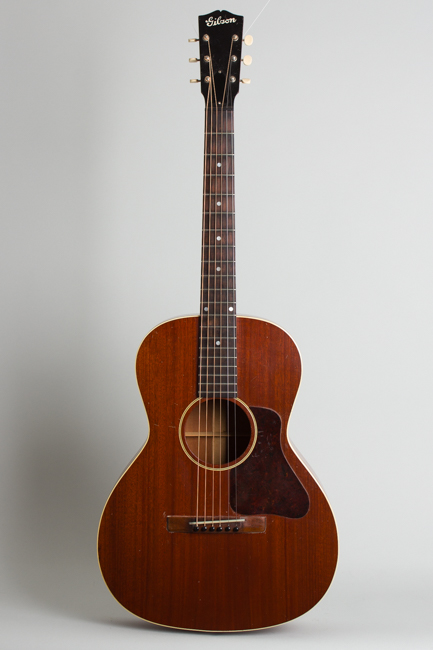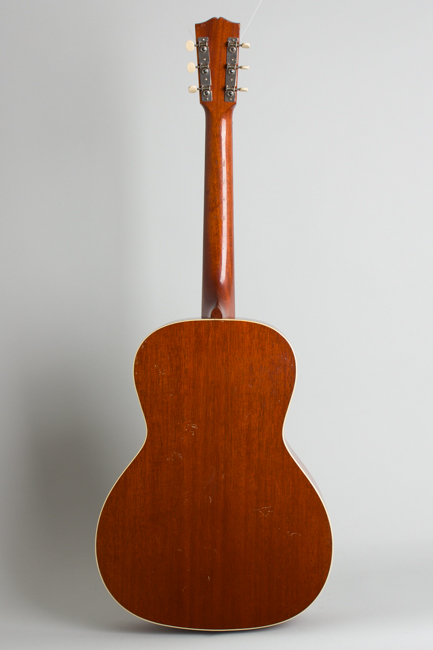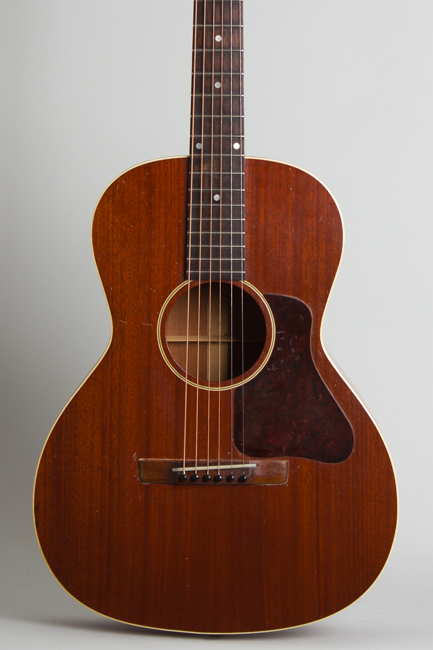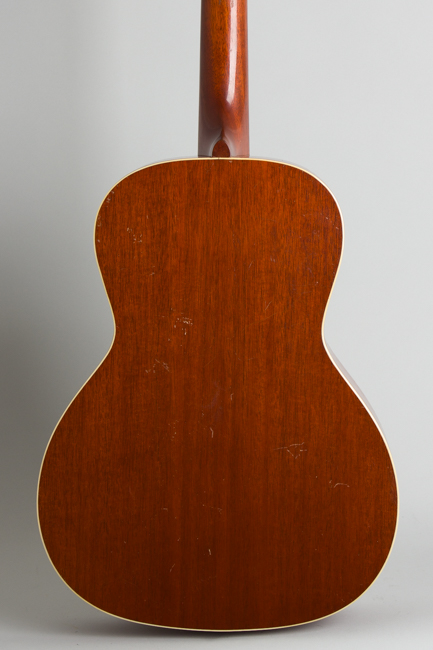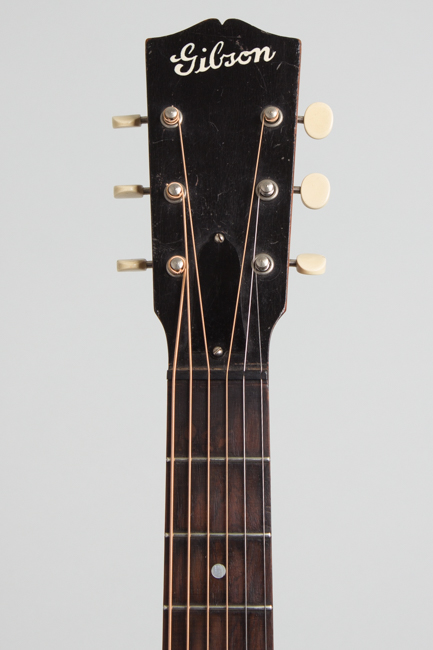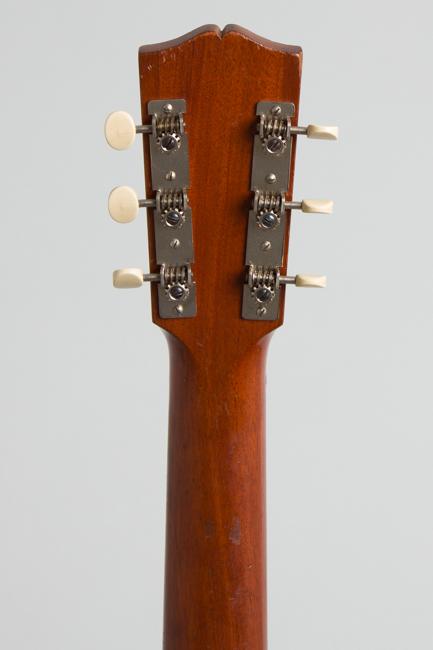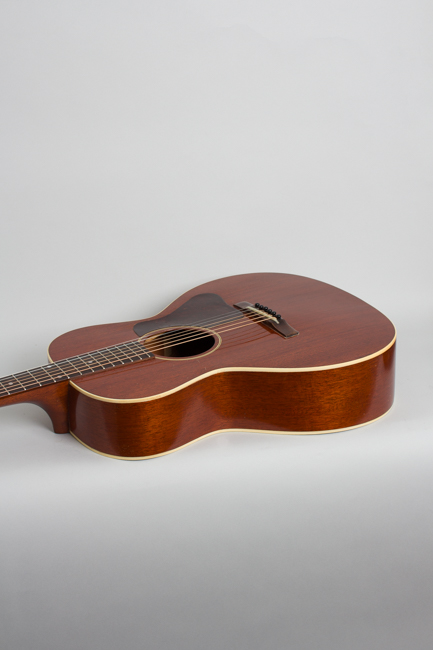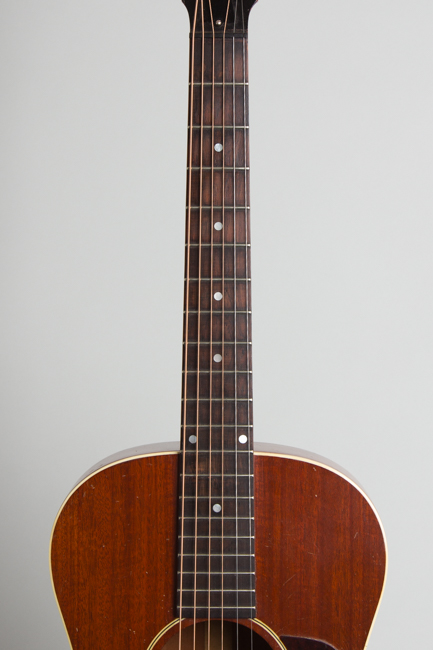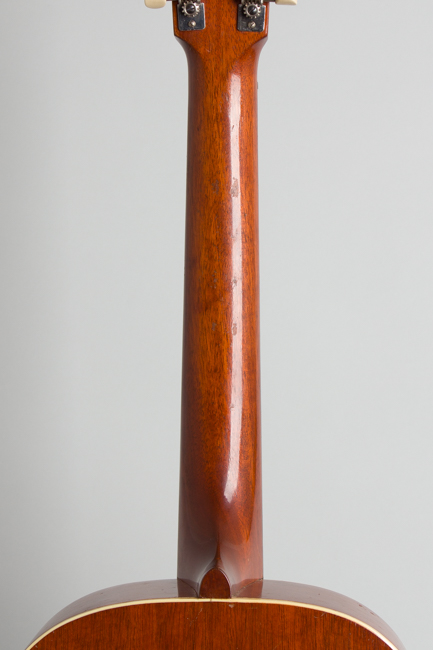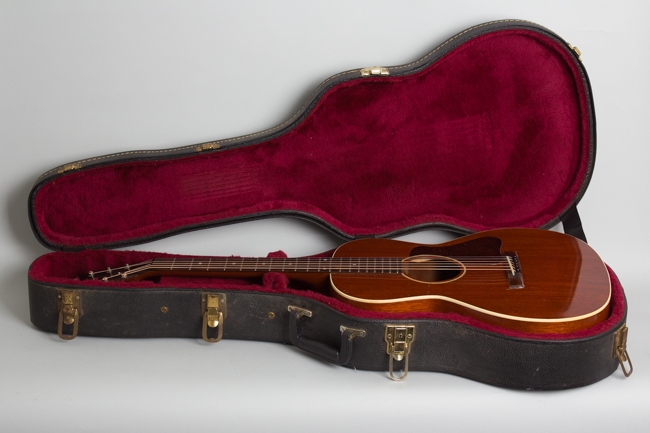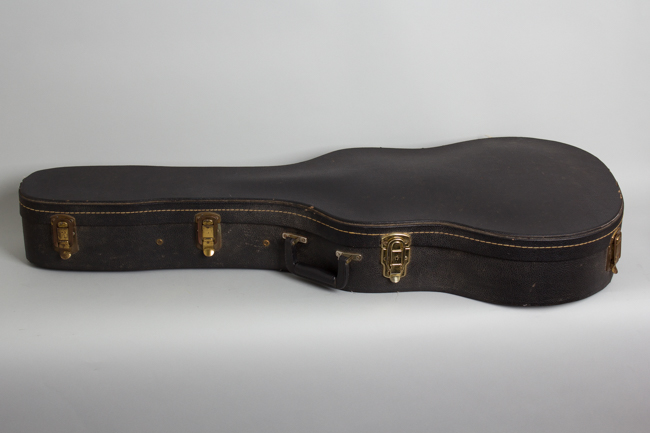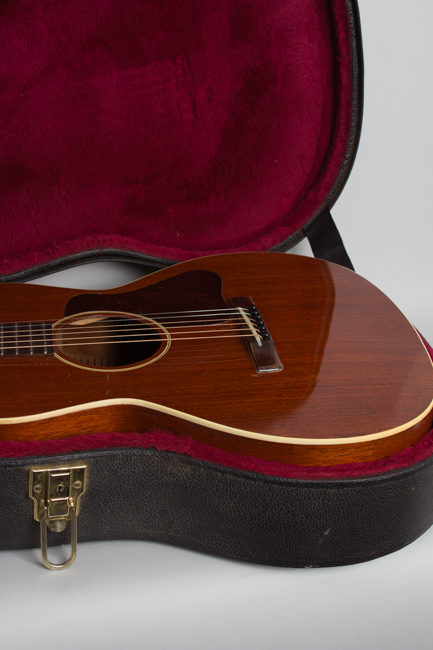Gibson L-0 Flat Top Acoustic Guitar (1932)
Gibson L-0 Model Flat Top Acoustic Guitar (1932), made in Kalamazoo, Michigan, serial # 254 (FON), dark mahogany lacquer finish, mahogany body and neck, ebonized fingerboard, black tolex hard shell case.
This instrument is late example of a rare Gibson flat-top produced only for a brief period from late 1929 into 1932. This all-mahogany, X-braced L-0 dates to 1932 and would be one of the last examples of the 12-fret version combining features from earlier and later eras. The most notable difference from the familiar later models is a 12-fret neck joint, a holdover from the 1920s; By 1932 both Gibson and Martin were moving to adopt the 14-fret design as standard for flat tops. The all-mahogany body is another feature Gibson soon moved on from; later models had spruce tops.
With a clear natural dark mahogany finish and white celluloid accents, this L-0 maintains an austere but elegant 1920s look on the more "modern" larger body of a 1930s flat-top guitar. This one has a very early example of the pickguard style Gibson would use through the 1930s; earlier models lacked this feature. The bridge is the standard slim rectangle fitted through the 1930s wothout the retainihg bolts added mid-decade.
The wider, less rounded body shape and X-braced top introduced on these flat top models in 1929 would be subsequently used on the 14-fret L-0 and L-00 throughout the 1930s. The natural lacquer finish would soon disappear; this guitar has the then brand-new white stencil "Gibson' logo used throughout the '30s in place of the earlier small silver script "The Gibson". While many of these have a very slim, flat neck for the period, this neck is a surprisingly deep and chunky rounded "C" profile, but still completely unlike the deeper heavy "V" adopted for these models after 1932.
These earliest 12-fret L-0s feature exceptionally light construction, even compared to later 1930s examples. The mahogany top is wafer-thin and the braces are very slim and marrow, even the main X. While we are partial to all pre-WWII Gibson flat-tops, we find the all-mahogany L-0 from this period to be practically unique; an austere but particularly attractive and exceptionally responsive instrument. The original list price was all of $35; what can we say but "Those were the days"!
Overall length is 38 1/2 in. (97.8 cm.), 14 3/4 in. (37.5 cm.) wide at lower bout, and 4 1/4 in. (10.8 cm.) in depth at side, taken at the end block. Scale length is 24 3/4 in. (629 mm.). Width of nut is 1 3/4 in. (44 mm.).
This 90+ year original L-0 is not pristine but still well preserved for one of these early Gibson flat tops. These all-mahogany instruments are *very* lightly built and many survivors are more heavily worn and/or much rebuilt. This guitar has some well-executed repairs but remains completely intact and an excellent player.
The thin lacquer finish has dings, dents, scrapes and general handling wear, but very few of the errant pick marks usually seen on older flattops. The back has scattered wear, with a some fairly random scratches but no heavy belt buckle wear. The white paint "Gibson" logo is nicely intact, the original inexpensive strip tuners are still fitted and work fine, as well as they ever did anyway. The back of the neck has a few shallow dings and dents down the spine.
There are no notable cracks which is sort of amazing for a guitar of this age and type. The bridge has been reglued, with some scarring and touch up around the base and noticeable polishing out of the finish in the area of the top around and behind it. There are several small grain checks to the mahogany in this area that never opened into actual cracks but are visible on close inspection.
The guitar has had a neatly done neck reset and the original bridge, tiny maple bridgeplate and delicate braces remain intact. Some brace regluing was likely done, and the lower forward tip of the main X may have been reshaped slightly; frankly some of the internal work on these is not particularly neat (compared to Martin at least) and it can be hard to discern what is a later repair from what is a rushed original job. The bridge plate has a couple of tiny patches to the pin holes on the lower strings.
What appear to be the original frets have some light wear and the guitar plays very will, with a powerful and robust sound less delicate than some. With its big chunky neck this L-0 has a different feel in the hand than most of this era, sort of a cross between the expected characteristics of this model and a '40s LG. It feels unique and we like it a lot, another quirky wonder from Gibson's restlessly creative Depression era period. Overall Very Good + Condition.
This instrument is late example of a rare Gibson flat-top produced only for a brief period from late 1929 into 1932. This all-mahogany, X-braced L-0 dates to 1932 and would be one of the last examples of the 12-fret version combining features from earlier and later eras. The most notable difference from the familiar later models is a 12-fret neck joint, a holdover from the 1920s; By 1932 both Gibson and Martin were moving to adopt the 14-fret design as standard for flat tops. The all-mahogany body is another feature Gibson soon moved on from; later models had spruce tops.
With a clear natural dark mahogany finish and white celluloid accents, this L-0 maintains an austere but elegant 1920s look on the more "modern" larger body of a 1930s flat-top guitar. This one has a very early example of the pickguard style Gibson would use through the 1930s; earlier models lacked this feature. The bridge is the standard slim rectangle fitted through the 1930s wothout the retainihg bolts added mid-decade.
The wider, less rounded body shape and X-braced top introduced on these flat top models in 1929 would be subsequently used on the 14-fret L-0 and L-00 throughout the 1930s. The natural lacquer finish would soon disappear; this guitar has the then brand-new white stencil "Gibson' logo used throughout the '30s in place of the earlier small silver script "The Gibson". While many of these have a very slim, flat neck for the period, this neck is a surprisingly deep and chunky rounded "C" profile, but still completely unlike the deeper heavy "V" adopted for these models after 1932.
These earliest 12-fret L-0s feature exceptionally light construction, even compared to later 1930s examples. The mahogany top is wafer-thin and the braces are very slim and marrow, even the main X. While we are partial to all pre-WWII Gibson flat-tops, we find the all-mahogany L-0 from this period to be practically unique; an austere but particularly attractive and exceptionally responsive instrument. The original list price was all of $35; what can we say but "Those were the days"!
Overall length is 38 1/2 in. (97.8 cm.), 14 3/4 in. (37.5 cm.) wide at lower bout, and 4 1/4 in. (10.8 cm.) in depth at side, taken at the end block. Scale length is 24 3/4 in. (629 mm.). Width of nut is 1 3/4 in. (44 mm.).
This 90+ year original L-0 is not pristine but still well preserved for one of these early Gibson flat tops. These all-mahogany instruments are *very* lightly built and many survivors are more heavily worn and/or much rebuilt. This guitar has some well-executed repairs but remains completely intact and an excellent player.
The thin lacquer finish has dings, dents, scrapes and general handling wear, but very few of the errant pick marks usually seen on older flattops. The back has scattered wear, with a some fairly random scratches but no heavy belt buckle wear. The white paint "Gibson" logo is nicely intact, the original inexpensive strip tuners are still fitted and work fine, as well as they ever did anyway. The back of the neck has a few shallow dings and dents down the spine.
There are no notable cracks which is sort of amazing for a guitar of this age and type. The bridge has been reglued, with some scarring and touch up around the base and noticeable polishing out of the finish in the area of the top around and behind it. There are several small grain checks to the mahogany in this area that never opened into actual cracks but are visible on close inspection.
The guitar has had a neatly done neck reset and the original bridge, tiny maple bridgeplate and delicate braces remain intact. Some brace regluing was likely done, and the lower forward tip of the main X may have been reshaped slightly; frankly some of the internal work on these is not particularly neat (compared to Martin at least) and it can be hard to discern what is a later repair from what is a rushed original job. The bridge plate has a couple of tiny patches to the pin holes on the lower strings.
What appear to be the original frets have some light wear and the guitar plays very will, with a powerful and robust sound less delicate than some. With its big chunky neck this L-0 has a different feel in the hand than most of this era, sort of a cross between the expected characteristics of this model and a '40s LG. It feels unique and we like it a lot, another quirky wonder from Gibson's restlessly creative Depression era period. Overall Very Good + Condition.
